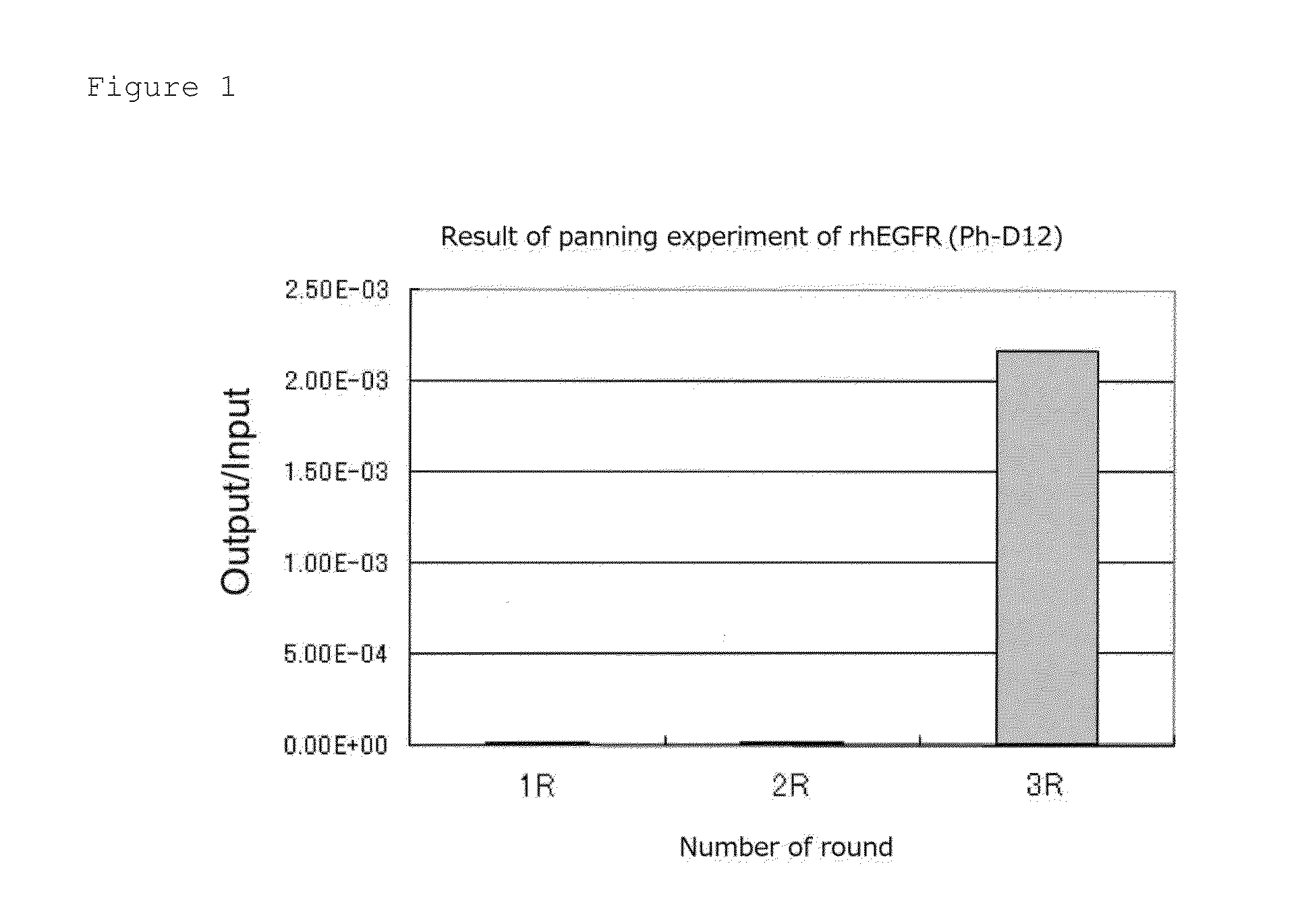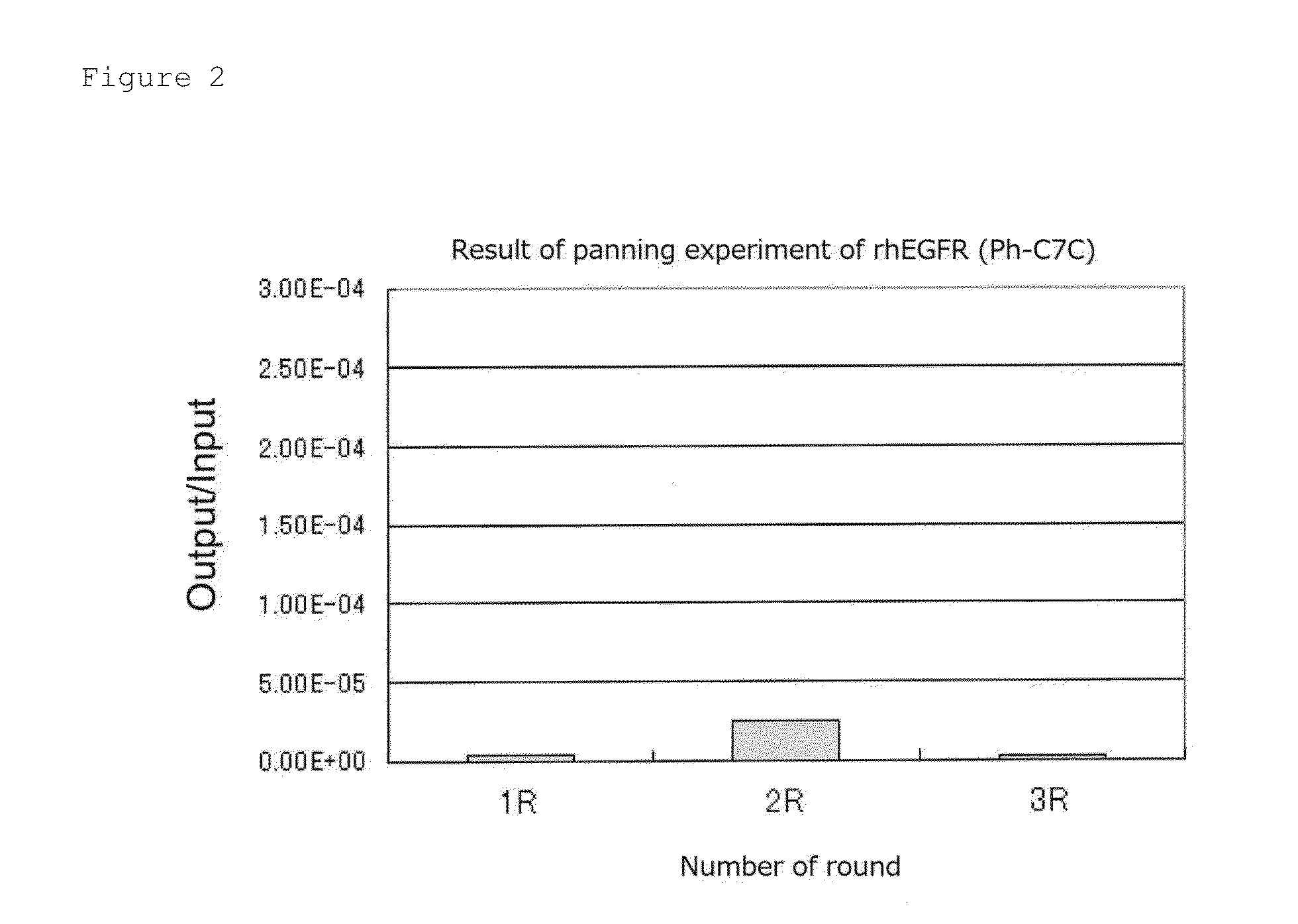Egfr-binding peptide
a technology of egfr and binding peptide, which is applied in the field of egfr-binding peptide, can solve the problems of adverse prognosis and high expression of egfr, and achieve the effect of specific and high binding properties
- Summary
- Abstract
- Description
- Claims
- Application Information
AI Technical Summary
Benefits of technology
Problems solved by technology
Method used
Image
Examples
example 1
[Procedure]
1. Panning Experiment—Round 1
[0103]5 μg / mL-Recombinant human IgG1 Fc (rhIgG1, R&D Systems) and recombinant human EGFR / Fc chimera (rhEGFR, R&D Systems) were individually added to a 96-well plate in each amount of 200 μL (1 μg / well), and stood still and incubated at 4° C. overnight (forming a solid phase on the plate). A non-solid phase protein in the wells was removed, thereto was added a blocking buffer (5 mg / mL BSA (bovine serum albumin) / TBS (50 mM Tris-HCl / 150 mM NaCl)) in an amount of 300 μL / well, the mixture was stool still and incubated at 37° C. for 1 hour and then washed three times with 200 μL / well of 0.1% TBST (0.1% Tween 20 / TBS).
[0104]100 μL of 0.1% TBST was added to the rhIgG1 solid phase well and a D12 phage library (1×1013PFU / mL) and a C7C phage library (2×1013 PFU / mL) were added thereto in each amount of 10 μL. Herein, 200 μl of 0.1% TBST was added to the rhEGFR solid phase well for the purpose of prevention of dryness.
*PFU: Plaque Forming Uni...
example 2
[Procedure]
[0114]A phage obtained in three rounds of the panning experiment using the D12 library was cloned according to a general method (Phage Display A Laboratory Manual, Cole Spring Harbor Laboratory Press, 2001) and the basic sequence of the phage displayed peptide part was determined. The determination of the basic sequence was made by a dideoxy termination method using a primer [−96gIII sequencing primer (5′-HOCCCTCATAGTTAGCGTAACG-3′) (SEQ ID No. 1), S1259A, NEB] which corresponds to a complementary strand of a basic sequence located in the downstream of 96 residues from the displayed peptide region. For migration of a reaction product and data analysis, a capillary sequencer was used.
RESULT
[0115]Displayed peptide sequences predicted from the determined basic sequences are shown in FIG. 3.
[0116]Among the sequences, the obtained I-1010 phage displayed peptide sequence (SEQ ID No. 2) had 6 clones having the same sequence in 15 clones that were examined in th...
example 3
(Test of Phage Binding Property (Condition of Formulation of Protein Solid Phase-1))
[Procedure]
[0118]A rhEGFR that is a target protein, rhIgG1 that is a rhEGFR-labeled Fc moiety, and BSA as a standard protein were added to a 96-well microplate to be 1 μg / well, and stood still at 4° C. overnight to be thus formed into a solid phase. A protein solution was removed, 300 μl of a blocking buffer was added and the mixture was incubated at 37° C. for 1 hour to thus block the wells. After removal of the blocking buffer, the wells were washed with 200 μl of 0.5% TBST being the washing solution three times and thereto was finally added 100 μl of 0.5% TBST. An amplification phage solution (I-1010, I-1012 and I-1015 phages and M13KE (peptide non-displayed phage)) was added to the above described wells to have 1×1010 PFU and mixed by pipetting. In the reaction, the mixture was gently shaken at room temperature for 1 hour. The reaction solution was removed and the wells were washed with 200 μl of...
PUM
| Property | Measurement | Unit |
|---|---|---|
| Affinity | aaaaa | aaaaa |
Abstract
Description
Claims
Application Information
 Login to View More
Login to View More - R&D
- Intellectual Property
- Life Sciences
- Materials
- Tech Scout
- Unparalleled Data Quality
- Higher Quality Content
- 60% Fewer Hallucinations
Browse by: Latest US Patents, China's latest patents, Technical Efficacy Thesaurus, Application Domain, Technology Topic, Popular Technical Reports.
© 2025 PatSnap. All rights reserved.Legal|Privacy policy|Modern Slavery Act Transparency Statement|Sitemap|About US| Contact US: help@patsnap.com



